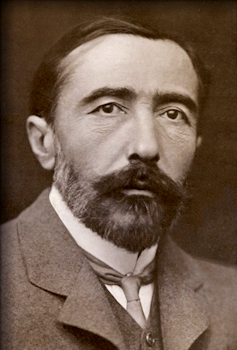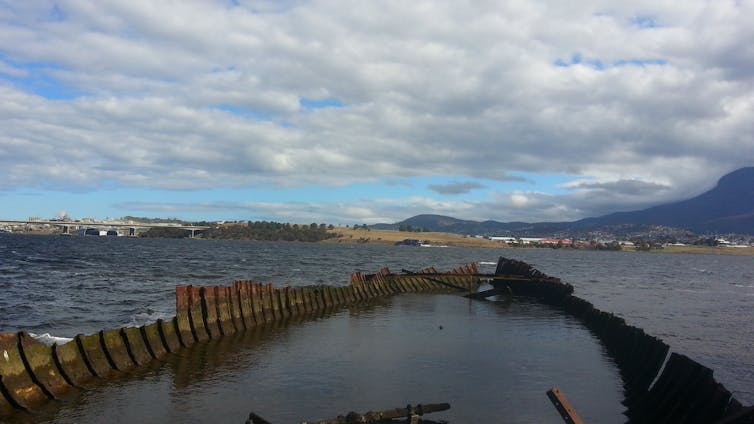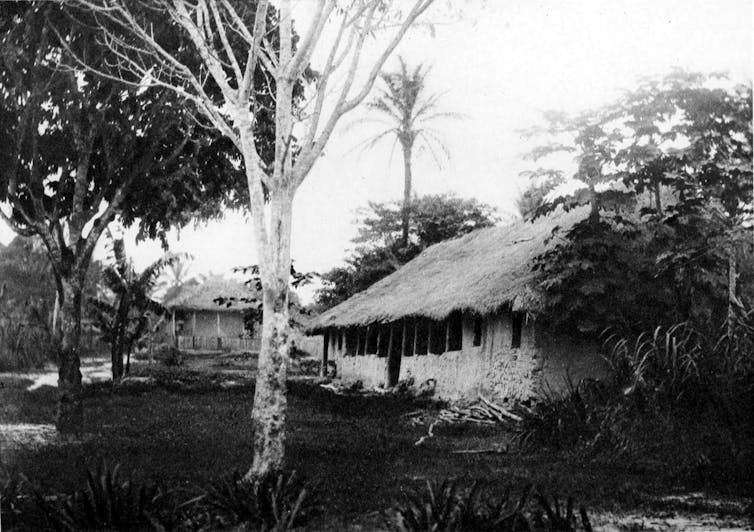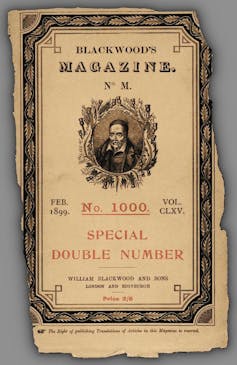How Conrad’s imperial horror story Heart of Darkness resonates with our globalised times
- Written by John Attridge, Senior Lecturer in English, UNSW
In our series, Guide to the classics, experts explain key works of literature.
Joseph Conrad’s Heart of Darkness - or “The Heart of Darkness”, as it was known to its first readers - was first published as a serial in 1899, in the popular monthly Blackwood’s Magazine. Few of that magazine’s subscribers could have foreseen the fame that Conrad’s story would eventually garner, or the fierce debates it would later provoke.
Already, in 1922, the American poet T.S. Eliot thought the book was Zeitgeist-y enough to provide the epigraph for his epoch-defining poem, The Waste Land - although another American poet, Ezra Pound, talked him out of using it.
The same thought occurred to Francis Ford Coppola more than 50 years later, when he used Conrad’s story as the framework for his phantasmagoric Vietnam War movie, Apocalypse Now. Echoes of Heart of Darkness can pop up almost anywhere: the chorus to a Gang of Four song, the title of a Simpsons episode, a scene in Peter Jackson’s 2005 King Kong remake.
Consider one final Heart of Darkness allusion, from Mohsin Hamid’s 2017 Man Booker-shortlisted novel, Exit West. In the novel’s opening pages, a man with “dark skin and dark, woolly hair” appears in a Sydney bedroom, transported there by one of the mysterious portals that have appeared around the globe, connecting stable, prosperous countries with places that people need to escape from.
The “door”, as these wormholes are called, is “a rectangle of complete darkness — the heart of darkness”. This is a more complicated kind of Conrad reference. Here, “heart of darkness” is a shorthand for European stereotypes of Africa, which Conrad’s novel did its part to reinforce.
Hamid’s line plays on racist anxieties about immigration: the idea that certain places and peoples are primitive, exotic, dangerous. For contemporary readers and writers, these questions have become an unavoidable part of Conrad’s legacy, too.
Up the river
Heart of Darkness is the story of an English seaman, Charles Marlow, who is hired by a Belgian company to captain a river steamer in the recently established Congo Free State. Almost as soon as he arrives in the Congo, Marlow begins to hear rumours about another company employee, Kurtz, who is stationed deep in the interior of the country, hundreds of miles up the Congo River.
 Joseph Conrad.
Wikimedia
Joseph Conrad.
Wikimedia
The second half of the novel - or novella, as it’s often labelled - relates Marlow’s journey upriver and his meeting with Kurtz. His health destroyed by years in the jungle, Kurtz dies on the journey back down to the coast, though not before Marlow has had a chance to glimpse “the barren darkness of his heart”. The coda to Marlow’s Congo story takes place in Europe: questioned by Kurtz’s “Intended” about his last moments, Marlow decides to tell a comforting lie, rather than reveal the truth about his descent into madness.
Although Conrad never met anyone quite like Kurtz in the Congo, the structure of Marlow’s story is based closely on his experiences as mate and, temporarily, captain of the Roi des Belges, a Congo river steamer, in 1890. By this time, Conrad, born Józef Teodor Konrad Korzeniowski in the Russian-ruled part of Poland in 1857, had been a seaman for about 15 years, rising to the rank of master in the British merchant service. (The remains of the only sailing ship he ever commanded, the Otago, have ended up in Hobart, a rusted, half-submerged shell on the banks of the Derwent.)
 The remains of the Otago, the boat Conrad commanded, in Hobart.
John Attridge
The remains of the Otago, the boat Conrad commanded, in Hobart.
John Attridge
Sick with fever and disenchanted with his colleagues and superiors, he broke his contract after only six months, and returned to London in early 1891. Three years and two ships later, Conrad retired from the sea and embarked on a career as a writer, publishing the novel that he had been working on since before he visited the Congo, Almayer’s Folly, in 1895. A second novel, An Outcast of the Islands, followed, along with several stories. Conrad’s second career was humming along when he finally set about transforming his Congo experience into fiction in 1898.
Darkness at home and abroad
Heart of Darkness opens on a ship, but not one of the commercial vessels that feature in Conrad’s sea stories. Rather, it’s a private yacht, the Nellie, moored at Gravesend, about 20 miles east of the City of London. The five male friends gathered on board were once sailors, but everyone except Marlow has since changed careers, as Conrad himself had done.
Like sail, which was rapidly being displaced by steam-power, Marlow is introduced to us as an anachronism, still devoted to the profession his companions have left behind. When, amidst the gathering “gloom”, he begins to reminisce about his stint as a “fresh-water sailor”, his companions know they are in for one of his “inconclusive experiences”.
Setting the opening of Heart of Darkness on the Thames also allowed Conrad to foreshadow one of the novel’s central conceits: the lack of any absolute, essential difference between so-called civilized societies and so-called primitive ones. “This, too”, Marlow says, “has been one of the dark places of the earth”, imagining the impressions of an ancient Roman soldier, arriving in what was then a remote, desolate corner of the empire.
During the second half of the 19th century, spurious theories of racial superiority were used to legitimate empire-building, justifying European rule over native populations in places where they had no other obvious right to be. Marlow, however, is too cynical to accept this convenient fiction. The “conquest of the earth”, he says, was not the manifest destiny of European peoples; rather, it simply meant “the taking it away from those who have a different complexion or slightly flatter noses than ourselves.”
 A Belgian river station in The Congo.
Wikimedia
A Belgian river station in The Congo.
Wikimedia
The idea that Africans and Europeans have more in common than the latter might care to admit recurs later, when Marlow describes observing tribal ceremonies on the banks of the river. Confronted with local villagers “stamping” and “swaying”, their “eyes rolling”, he is shaken by a feeling of “remote kinship with this wild and passionate uproar”.
Whereas most contemporary readers will be cheered by Marlow’s scepticism about the project of empire, this image of Congo’s indigenous inhabitants is more problematic. “Going up that river”, Marlow says, “was like travelling back to the earliest beginnings of the world”, and he accordingly sees the dancing figures as remnants of “prehistoric man”.
Heart of Darkness suggests that Europeans are not essentially more highly-evolved or enlightened than the people whose territories they invade. To this extent, it punctures one of the myths of imperialist race theory. But, as the critic Patrick Brantlinger has argued, it also portrays Congolese villagers as primitiveness personified, inhabitants of a land that time forgot.
Kurtz is shown as the ultimate proof of this “kinship” between enlightened Europeans and the “savages” they are supposed to be civilising. Kurtz had once written an idealistic “report” for an organisation called the International Society for the Suppression of Savage Customs. When Marlow finds this manuscript among Kurtz’s papers, however, it bears a hastily-scrawled addendum: “Exterminate all the brutes!” The Kurtz that Marlow finally encounters at the end of the novel has been consumed by the same “forgotten and brutal instincts” he once intended to suppress.
Adventure on acid
The European “gone native” on the fringes of empire was a stock trope, which Conrad himself had already explored elsewhere in his writing, but Heart of Darkness takes this cliché of imperial adventure fiction and sends it on an acid trip. The manic, emaciated Kurtz that Marlow finds at the Inner Station is straight out of the pages of late-Victorian neo-Gothic, more Bram Stoker or Sheridan Le Fanu than Henry Rider Haggard. The “wilderness” has possessed Kurtz, “loved him, embraced him, got into his veins” — it is no wonder that Marlow feels “creepy all over” just thinking about it.
 Heart of Darkness was first serialised in Blackwood’s Magazine.
Wikimedia
Heart of Darkness was first serialised in Blackwood’s Magazine.
Wikimedia
Kurtz’s famous last words are “The horror! The horror!” “Horror” is also the feeling that Kurtz and his monstrous jungle compound, with its decorative display of human heads, are supposed to evoke in the reader. Along with its various other generic affiliations — imperial romance, psychological novel, impressionist tour de force — Heart of Darkness is a horror story.
Conrad’s Kurtz also channels turn-of-the-century anxieties about mass media and mass politics. One of Kurtz’s defining qualities in the novel is “eloquence”: Marlow refers to him repeatedly as “A voice!”, and his report on Savage Customs is written in a rhetorical, highfalutin style, short on practical details but long on sonorous abstractions. Marlow never discovers Kurtz’s real “profession”, but he gets the impression that he was somehow connected with the press — either a “journalist who could paint” or a “painter who wrote for the papers”.
This seems to be confirmed when a Belgian journalist turns up in Antwerp after Kurtz’s death, referring to him as his “dear colleague” and sniffing around for anything he can use as copy. Marlow fobs him off with the bombastic report, which the journalist accepts happily enough. For Conrad, implicitly, Kurtz’s mendacious eloquence is just the kind of thing that unscrupulous popular newspapers like to print.
If Kurtz’s “colleague” is to be believed, moreover, his peculiar gifts might also have found an outlet in populist politics: “He would have been a splendid leader of an extreme party.” Had he returned to Europe, that is, the same faculty that enabled Kurtz to impose his mad will on the tribespeople of the upper Congo might have found a wider audience.
Politically, Conrad tended to be on the right, and this image of Kurtz as an extremist demagogue expresses a habitual pessimism about mass democracy — in 1899, still a relatively recent phenomenon. Nonetheless, in the light of the totalitarian regimes that emerged in Italy, Germany and Russia after 1918, Kurtz’s combination of irresistible charisma with megalomaniacal brutality seems prescient.
These concerns about political populism also resonate with recent democratic processes in the US and the UK, among other places. Only Conrad’s emphasis on “eloquence” now seems quaint: as the 2016 US Presidential Election demonstrated, an absence of rhetorical flair is no handicap in the arena of contemporary populist debate.
Race and empire
Heart of Darkness contains a bitter critique of imperialism in the Congo, which Conrad condemns as “rapacious and pitiless folly”. The backlash against the systematic abuse and exploitation of Congo’s indigenous inhabitants did not really get underway until the first decade of the 20th century, so that the anti-imperialist theme was ahead of its time, if only by a few years. Nor does Conrad have any patience with complacent European beliefs about racial superiority.
 Heart of Darkness sees horror in the Congo’s rainforests.
Shutterstock.com
Heart of Darkness sees horror in the Congo’s rainforests.
Shutterstock.com
Nonetheless, the novel also contains representations of Africans that would rightly be described as racist if they were written today. In particular, Conrad shows little interest in the experience of Marlow’s “cannibal” shipmates, who come across as exotic caricatures. It is images like these that led the Nigerian novelist Chinua Achebe to denounce Conrad as a “bloody racist”, in an influential 1977 essay.
One response to this criticism is to argue, as Paul B. Armstrong does, that the lack of more rounded Congolese characters is the point. By sticking to Marlow’s limited perspective, Heart of Darkness gives an authentic portrayal of how people see other cultures. But this doesn’t necessarily make the images themselves any less offensive.
If Achebe did not succeed in having Heart of Darkness struck from the canon, he did ensure that academics writing about the novel could no longer ignore the question of race. For Urmila Seshagiri, Heart of Darkness shows that race is not the stable, scientific category that many Victorians thought it was. This kind of argument shifts the debate in a different direction, away from the author’s putative “racism”, and onto the novel’s complex portrayal of race itself.
Perhaps because he was himself an alien in Britain, whose first career had taken him to the farthest corners of the globe, Conrad’s novels and stories often seem more in tune with our globalized world than those of some of his contemporaries. An émigré at 16, Conrad experienced to a high degree the kind of dislocation that has become an increasingly typical modern condition. It is entirely appropriate, in more ways than one, for Hamid to allude to Conrad in a novel about global mobility.
The paradox of Heart of Darkness is that it seems at once so improbable and so necessary. It is impossible not to be astonished, when you think of it, that a Polish ex-sailor, writing in his third language, was ever in a position to author such a story, on such a subject. And yet, in another way, Conrad’s life seems more determined than most, in more direct contact with the great forces of history. It is from this point of view that Heart of Darkness seems necessary, even inevitable, the product of dark historical energies which continue to shape our contemporary world.
Authors: John Attridge, Senior Lecturer in English, UNSW



















